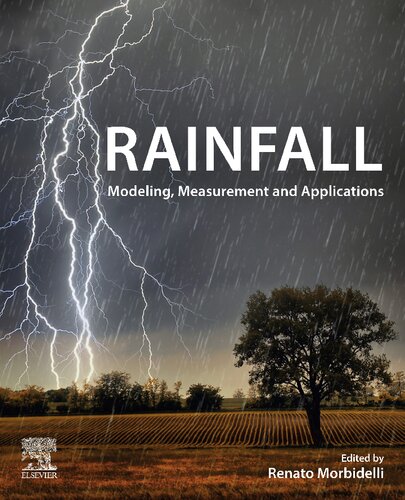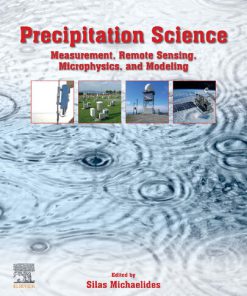Rainfall Modeling Measurement and Applications 1st Edition by Renato Morbidelli ISBN 9780128225448 0128225440
$50.00 Original price was: $50.00.$25.00Current price is: $25.00.
Rainfall Modeling Measurement and Applications 1st Edition by Renato Morbidelli – Ebook PDF Instant Download/Delivery: 9780128225448 ,0128225440
Full download Rainfall Modeling Measurement and Applications 1st Edition after payment

Product details:
ISBN 10: 0128225440
ISBN 13: 9780128225448
Author: Renato Morbidelli
Rainfall: Physical Process, Measurement, Data Analysis and Usage in Hydrological Investigations integrates different rainfall perspectives, from droplet formation and modeling developments to the experimental measurements and their analysis, to application in surface and subsurface hydrological investigations. Each chapter provides an updated representation of the involved subject with relative open problems and includes a case study at the end of the chapter. The book targets postgraduate readers studying meteorology, civil and environmental engineering, geophysics, agronomy and natural science, as well as practitioners working in the fields of hydrology, hydrogeology, agronomy and water resource management.
- Presents comprehensive coverage of rainfall-related topics, from the basic processes involved in the drop formation to data use and modeling
- Provides real-life examples for practical use in the form of a case study in each chapter
Rainfall Modeling Measurement and Applications 1st Edition Table of contents:
Chapter 1 Rainfall microphysics
Abstract
1.1 Introduction
1.2 The warm rain process
1.3 Cold rain process
1.4 Conclusion
Acknowledgments
References
Chapter 2 Meteorological systems producing rainfall
Abstract
2.1 Introduction
2.2 Schematization of frontal systems
2.3 Rainfall fields associated to mid-latitude frontal systems
2.4 Interaction between frontal systems and orographic barriers in the low levels of troposphere
2.5 Study cases
2.6 Conclusions
References
Chapter 3 Rainfall modeling
Abstract
3.1 Introduction
3.2 Simulation of precipitating system dynamics
3.3 Modeling of cloud microphysics
3.4 Convection-permitting modeling: anelastic versus compressible approach
3.5 Prospects for future rainfall modeling
Acknowledgements
References
Chapter 4 Rain gauge measurements
Abstract
4.1 Introduction
4.2 Principles and operation of rain gauges
4.3 Accuracy of tipping-bucket and weighing gauges
4.4 Calibration procedures and standardization
4.5 The impact of wind on rainfall measurements
4.6 Rain gauge network design
4.7 Concluding remarks
References
Chapter 5 Rainfall estimation by weather radar
Abstract
5.1 Introduction
5.2 Rainfall microstructure
5.3 Radar principles
5.4 The radar equation
5.5 Errors in radar rainfall estimation and their correction
5.6 Radar – raingauge merging and assessment of radar rainfall uncertainty
5.7 Dual polarization
5.8 Conclusions
References
Chapter 6 Satellite rainfall estimation
Abstract
6.1 Introduction
6.2 Satellites and sensors
6.3 Precipitation retrievals from satellite observations
6.4 Validation of satellite precipitation products
6.5 Case study: hurricane Laura observed by the GPM Core Observatory
6.6 Recent developments and future directions
6.7 Conclusion
References
Chapter 7 Time resolution of rain gauge data and its hydrological role
Abstract
7.1 Introduction
7.2 Rainfall data types
7.3 Rainfall data time-resolution in different geographic areas of the world
7.4 Effect of data time-resolution on the estimate of annual maximum rainfall depths
7.5 Rainfall data time-resolution and its role in the hydrological applications
7.6 Case study: Umbria region in central Italy
7.7 Conclusions
References
Chapter 8 Mean areal precipitation estimation: methods and issues
Abstract
8.1 Introduction
8.2 Mean areal precipitation
8.3 Mean areal precipitation estimation: weighting methods
8.4 Surface generation methods
8.5 Radar and satellite-based methods
8.6 Computationally intensive estimation methods
8.7 Mean areal precipitation estimation: issues
8.8 Evaluation of mean areal precipitation estimation methods
8.9 Recommendations for selection of a mean areal precipitation estimation method
8.10 Conclusions
References
Chapter 9 Ombrian curves advanced to stochastic modeling of rainfall intensity
Abstract
9.1 Introduction
9.2 A stochastic framework for building ombrian models
9.3 Building a theoretically consistent ombrian model
9.4 Model fitting procedure
9.5 Development of an ombrian model for Bologna in Italy
9.6 Discussion and further aspects
9.7 Conclusions
References
Chapter 10 Areal reduction factor estimate for extreme rainfall events
Abstract
10.1 Introduction
10.2 Main dependencies of areal reduction factors
10.3 Different methodologies for estimating areal reduction factors
10.4 Comparisons and possibility of transposition of different ARFs approaches
10.5 A new ARFs empirical formulation in Umbria, central Italy
10.6 Conclusions
References
Chapter 11 Analysis of extreme rainfall events under the climatic change
Abstract
11.1 Introduction
11.2 Rainfall extremes and their analysis
11.3 Observed changes to rainfall extremes
11.4 Projected changes to rainfall extremes
11.5 Conclusions
References
Chapter 12 Rainfall regionalization techniques
Abstract
12.1 Introduction
12.2 Variables to be regionalized, data preparation, and data scarcity
12.3 Regional methods
12.4 Methods adopted in practice
12.5 Considerations on applicability and evolution of the regional frequency analyses
12.6 Conclusions
References
Chapter 13 Rainfall and development of floods
Abstract
13.1 Introduction
13.2 Formation and separation of the flood hydrograph
13.3 A modeling framework for flood simulation and real-time flood forecasting
13.4 A short description of the implicit functions incorporated in the real-time flood forecasting model framework
13.5 Rainfall-runoff for designing extreme floods
13.6 Conclusions
References
Chapter 14 Rainfall and infiltration
Abstract
14.1 Introduction
14.2 Rainfall-infiltration process
14.3 Point infiltration methods
14.4 Rainfall-infiltration process at field scale
14.5 Case study
14.6 Conclusions
14.7 Recent developments and challenges
References
Chapter 15 Rainfall and erosion/sediment transport
Abstract
15.1 The erosive power of the rainfall
15.2 Raindrop impact on the soil surface
15.3 Overview of soil erosion models
15.4 Conclusions
References
Chapter 16 Rainfall and landslide initiation
Abstract
16.1 Introduction
16.2 Modeling the relationships between rainfall and landslide
16.3 The TRIGRS physically-based model
16.4 Rainfall thresholds for landslide initiation
16.5 Operational prediction and forecasting of rainfall-induced landslides
16.6 Case study: frequentist thresholds for landslide initiation in Italy
16.7 Conclusions
References
Chapter 17 Rainfall and droughts
Abstract
17.1 Introduction
17.2 Drought hydrology and generating processes
17.3 Drought indices
17.4 Case study: drought characterization using SPI, SPEI, and PDSI
17.5 Conclusion
References
Index
People also search for Rainfall Modeling Measurement and Applications 1st Edition:
rainfall measurement app
rainfall measurement explained
rainfall measurements
rainfall measurements are measured to an accuracy of
rainfall modelling and simulation
Tags:
Renato Morbidelli,Rainfall,Modeling,Measurement,Applications
You may also like…
Uncategorized
Computers - Computer Science
Biology and other natural sciences - Biophysics
Food Physics: Physical Properties – Measurement and Applications 2nd Edition Ludger O. Figura
Mathematics - Mathematical Statistics
Measurement Uncertainty Methods and Applications Fifth Edition Dieck
Mathematics
Science (General) - Research & Development
Advances in Applications of Rasch Measurement in Science Education 1st Edition Xiufeng Liu
Education Studies & Teaching - Educational Theory
Jurisprudence & Law - General & Miscellaneous Law
Equity in the Civil Law Tradition 1st Edition Renato Beneduzi











